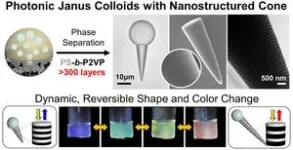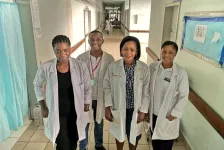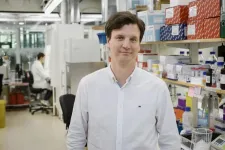(Press-News.org) A groundbreaking technology that enables the real-time display of colors and shapes through changes in nanostructures has been developed. This innovative technology, pioneered by Professor Kang Hee Ku and her team in the School of Energy and Chemical Engineering at UNIST, has the potential to revolutionize various fields, such as smart polymer particles.
Utilizing block copolymers, the research team has achieved the self-assembly of photonic crystal structures on a large scale, mimicking natural phenomena observed in butterfly wings and bird feathers. By reflecting the shape and direction of nanostructures, this technology allows for the visualization of vibrant colors and intricate patterns in real time.
Block copolymers, composed of two or more different monomers covalently bonded in a block shape, were strategically employed to induce phase separation using a non-mixing liquid droplet. Professor Ku emphasized the significance of this achievement, stating, “We have successfully generated hundreds of flawless photonic crystal structures through the autonomous organization of block copolymers, eliminating the need for external manipulation.”
Setting itself apart from conventional methods, this cutting-edge technology leverages internal nanostructures to create colors that are vivid, long-lasting, and sustainable. Furthermore, its enhanced applicability in display technology is evident through its capability to pattern large areas efficiently.
The key innovation lies in the use of a polymer that can dynamically adjust the size of microstructures within particles in response to changes in the external environment. By leveraging the unique properties of polystyrene-polyvinylpyridine (PS-b-P2VP) block copolymers, the structure, shape, and color of the particles can be tailored, reverting to their original state despite environmental variations.
Real-time monitoring of structural changes revealed that the size and color of micro-nanostructures adapt to fluctuations in alcohol concentration or pH value. Notably, the particles produced through this technology exhibit an innovative ‘Ice Cream Cone’ shape structure, combining aspects of solids and liquids to visualize fluid vibrations and dynamically alter shape and color in response to external stimuli.
Professor Ku showed confidence about the potential applications of this research, stating, “This study opens doors to the creation of self-assembling optical particles, streamlining the complex process conditions typically associated with colloidal crystal structure and pattern formation.” She further noted, “The technology’s practical applications in smart paint and polymer particles across various industries are envisioned.”
Published in the February 2024 issue of ACS Nano, the research received support from the National Research Foundation of Korea (NRF), the Ministry of Science and ICT (MSIT), and the Korea Toray Science Foundation, underscoring collaborative efforts driving this groundbreaking innovation.
Journal Reference
Juyoung Lee, Soohyun Ban, Kyuhyung Jo, et al., “Dynamic Photonic Janus Colloids with Axially Stacked Structural Layers,” ACS Nano, (2024).
END
Breakthrough in nanostructure technology for real-time color display
2024-03-11
ELSE PRESS RELEASES FROM THIS DATE:
Americans' trust in scientific expertise survived polarization, Trump attacks on science
2024-03-11
Americans' basic confidence in science and scientific expertise was unshaken by the Trump administration's attacks on scientific expertise, and has remained high during the last six decades, according to an analysis led by the University of Michigan.
Trump's attacks on scientific experts—exemplified by criticism of Anthony Fauci, former director of the National Institute of Allergy and Infectious Diseases—increased the level of partisan polarization in the United States and made the question of scientific expertise more salient ...
Unveiling Inaoside A: An antioxidant derived from mushrooms
2024-03-11
Natural products have unique chemical structures and biological activities and can play a pivotal role in advancing pharmaceutical science. In a pioneering study, researchers from Shinshu University discovered Inaoside A, an antioxidant derived from Laetiporus cremeiporus mushrooms. This breakthrough sheds light on the potential of mushrooms as a source of therapeutic bioactive compounds.
The search for novel bioactive compounds from natural sources has gained considerable momentum in recent years due to the need for new therapeutic ...
Improving care of hospitalized patients with HIV in Tanzania
2024-03-11
Researchers at Weill Cornell Medicine have shown that three months of social worker follow-up support to people hospitalized with HIV in Tanzania had health benefits at low cost. The protocol shortened the time it took participants to attend an HIV clinic and to start on antiretroviral therapy after discharge.
However, the study published in JAMA on Mar. 6 found that the care benefits didn’t translate to a decrease in mortality after one year. They compared a group that received extended case management intervention with a control group receiving ...
Researchers uncover protein responsible for cold sensation
2024-03-11
University of Michigan researchers have identified the protein that enables mammals to sense cold, filling a long-standing knowledge gap in the field of sensory biology.
The findings, published in Nature Neuroscience, could help unravel how we sense and suffer from cold temperature in the winter, and why some patients experience cold differently under particular disease conditions.
"The field started uncovering these temperature sensors over 20 years ago, with the discovery of a heat-sensing protein called TRPV1," said neuroscientist Shawn ...
Experts create blueprint to aid elderly people at storm flood risk
2024-03-11
Emergency planners in Shanghai and New York City face increasing pressure to protect elderly citizens from the devastating impact of coastal flooding caused by storms and cyclones, a new study reveals.
Both cities are highly exposed to storm-induced flooding and analysis shows that - with two distinct systems of emergency operation – there are significant differences between them in evacuating elderly people to safety.
After studying emergency operations in the cities, experts devised a blueprint for efficient evacuation that could be used in similar flood-threatened cities around the globe such as Mumbai, Bangkok, Jakarta, Ho Chi Minh City, Miami, ...
Dangers of smell impairment highlighted in new research
2024-03-11
Peer-reviewed – survey - people
More than a third of people who self-identify as having a smell disorder have had at least one gas safety scare in the last five years, according to new research.
The study, led by the University of East Anglia (UEA) in collaboration with the charity Fifth Sense, asked people who cannot smell well what safety concerns they had and if they had experienced any hazardous events.
A total of 432 people responded to the online survey, which was conducted from February 25 to September 28, 2022, and distributed via the charity.
It ...
Leonid Sazanov wins Schrödinger Award
2024-03-11
At school, he was inspired by Schrödinger´s book ‘What is Life?’. Now, several decades later, Leonid Sazanov is awarded the Erwin Schrödinger Prize by the Austrian Academy of Sciences (ÖAW). The scientist heads a research group at the Institute of Science and Technology Austria (ISTA) and was honored “for his outstanding achievements in the field of structural biology of membrane protein complexes.” Sazanov is the sixth ISTA scientist to receive the prestigious Schrödinger Award.
“I am especially ...
Does worsening metabolic syndrome increase the risk of developing cancer?
2024-03-11
New research indicates that individuals with persistent and worsening metabolic syndrome—which encompasses conditions such as high blood pressure, elevated blood sugar, excess abdominal fat, and abnormal cholesterol—face an elevated risk of developing various types of cancer. The findings are published by Wiley online in CANCER, a peer-reviewed journal of the American Cancer Society.
In the study, 44,115 adults in China with an average age of 49 years were categorized into 4 different trajectories based on trends from ...
New study reveals transgenerational effects of pesticide linuron on frogs
2024-03-11
Grand-offspring of male frogs exposed to the pesticide linuron exhibited changes in their DNA that was linked to significant physiological impacts, a study from Stockholm University reveals. The research highlights the profound transgenerational consequences of environmental pollution on amphibian populations, which are already under threat of extinction. The study is published in the journal Science of the Total Environment.
Amphibians, particularly frogs, play a crucial role in our ecosystem. However, nearly half of all amphibian species ...
Harvard and ONO Pharmaceutical launch university-wide alliance to address multiple disease areas
2024-03-11
Harvard University and Ono Pharmaceutical Co., Ltd. (ONO) have launched a strategic alliance to advance research across a broad range of therapeutic areas. This collaborative effort marks a significant commitment to identify and develop first-in-class therapeutics for medical conditions in the areas of oncology, immunology, neurology, and specialty.
Through a five-year strategic research alliance spearheaded by Harvard’s Office of Technology Development, the request for proposals will be for research projects focused on the validation of novel therapeutic targets from labs across Harvard University including Harvard Medical ...





